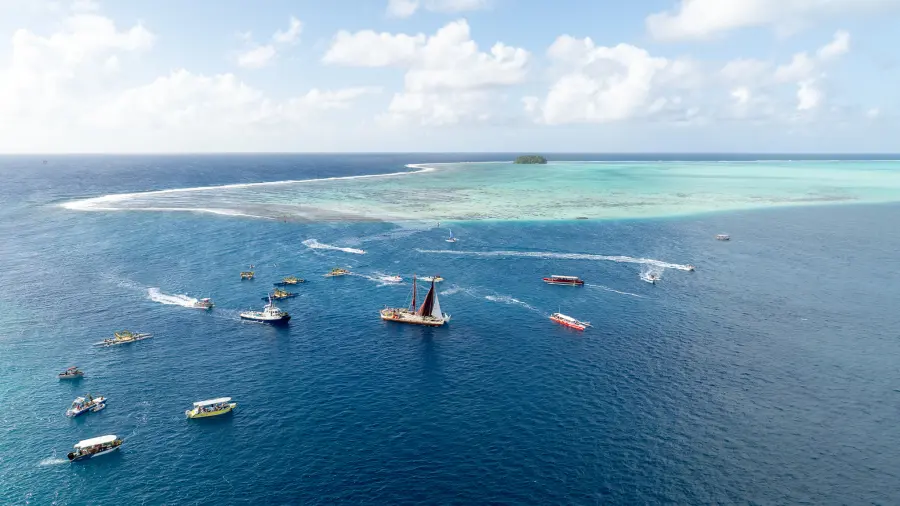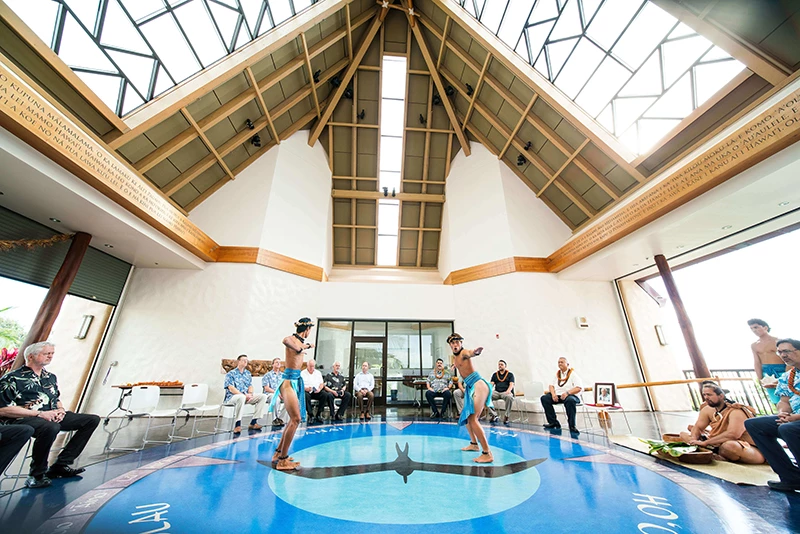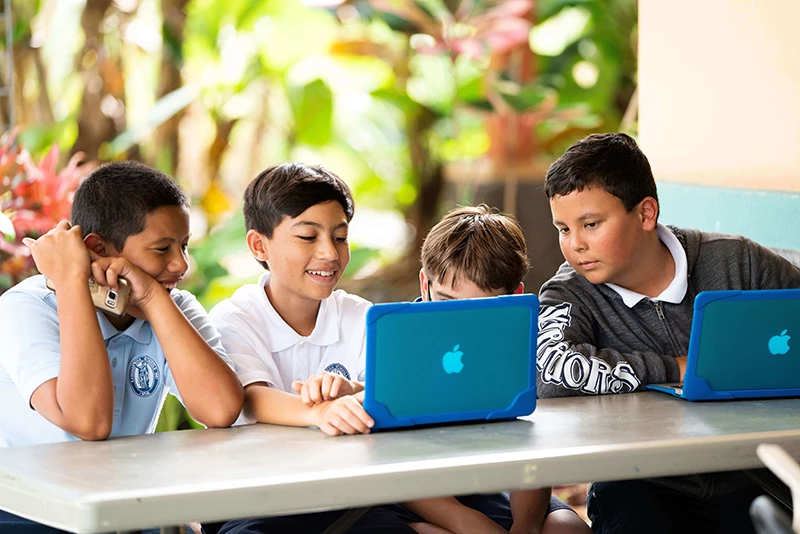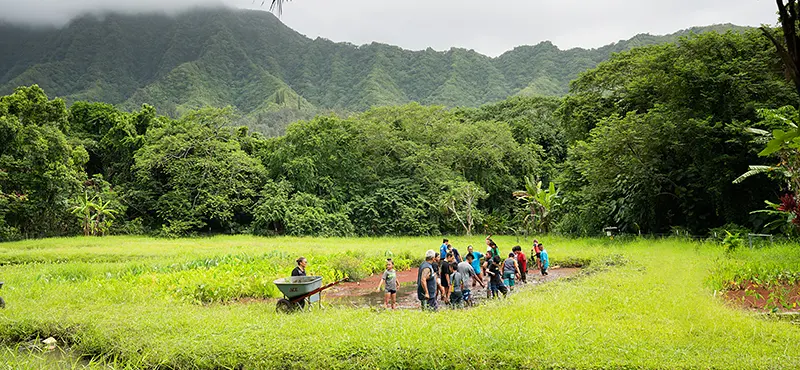For 50 years, Kamehameha Schools and Kaʻiwakīloumoku Pacific Indigenous Institute have helped steward the cultural legacy of Hōkūleʻa. This on-going series provides insights into the ceremonies, collaborations and shared commitments that unite the peoples across Moananuiākea.
When the Moananuiākea Voyage for the Pacific relaunched in June 2025, revered Hōkūleʻa navigator Nainoa Thompson decided his target destination in French Polynesia should be Taputapuātea on the island of Raʻiātea, then Papeʻete in Tahiti. A center of ancestral knowledge and a mecca for chiefly navigators for centuries, Taputapuātea’s status as one of the most sacred sites in Polynesia, as well as its designation as a UNESCO World Heritage Site, compelled Thompson to seek the support of Kamehameha Schools. He contacted the Kaʻiwakīloumoku Pacific Indigneous Institute of the Hoʻokahua Cultural Vibrancy Group, a longtime partner in Hōkūleʻa’s voyages throughout the world.

Hōkūleʻa and Hikianalia receiving the okay to travel through the sacred Teava Moa pass leading to Taputapuātea, Raʻiātea.
Hōkūleʻa and Hikianalia receiving the okay to travel through the sacred Teava Moa pass leading to Taputapuātea, Raʻiātea.
Kamehameha Schools has been a heritage keeper and culture bearer for the waʻa for some fifty years. On March 8, 1975, on the occasion of its initial launch into the waters of Kualoa, Oʻahu, Hōkūleʻa was blessed and consecrated in traditional ceremonies officiated by KS alumni Kaʻupena Wong, Kalena Silva and Keliʻi Tauʻā. They were assisted by select junior and senior students specializing in Hawaiian studies, music and dance. Since then, she has sailed across the world, representing Native Hawaiians and Hawaiʻi on international stages. Making landfall at locations of high cultural, political and religious significance can be complicated, and requires protocol, research, insight, creativity, and a genuine sense of joy in working with other Indigenous communities. Even relationships that have been forged over many years are honored and tested as “visitors” and “hosts” negotiate protocols and privileges for each interaction — it’s the Pacific way.
The legacy of heritage-keeping for the waʻa has helped shape the educational experience at Kamehameha Schools, in particular for the Hawaiian Ensemble at KS Kapālama. Students train throughout the year for ceremonial protocol and become well acquainted with the physical and spiritual demands of this kuleana.
In June 2025, Hōkūleʻa’s arrival in Raʻiātea marked the first time she had traveled along the ancestral pathway Kealaikahiki directly to the sacred site of Marae Taputapuātea. Thirteen students and recent graduates from the Kapālama campus formed the backbone of the Kamehameha Tahiti delegation. With each element of the ceremony carefully shaped, Kamehameha’s kuleana was to help prepare and guide the leadership and crews of Hōkūleʻa and Hikianalia upon landfall. At Taputapuātea, the crews disembarked and stood in waist-deep water near the shore. A pū was sounded, signaling the start of “A Honua,” a mele kāhea seeking permission to enter a new space. It was followed by “Pule Hoʻomaikaʻi no ka Waʻa” which places a cloak of protection on all who are gathered. “Auē, Ua Hiti Ē!” is an exuberant expression of joy for safe landfall.

Kumu and cultural practitioner Lāiana Kanoa-Wong preparing ʻawa for ceremony at Marae Taputapuātea.
Kumu and cultural practitioner Lāiana Kanoa-Wong preparing ʻawa for ceremony at Marae Taputapuātea.
In celebration of Hōkūleʻa’s 50th anniversary, a maroon kīhei with a “Kūikawelo” design, first used in the 1999 voyage to Rapa Nui, was tied on each crew member. Crew leaders carried two stones from the waʻa to Ōputeina, a small marae along the shore dedicated to transient voyagers on pilgrimages to the sacred site. The ancestral gifting and exchange of stones was traditionally used to establish new marae. Stones gifted to the waʻa three years ago were brought ashore for the arrival before being returned to the waʻa so they could continue the journey as part of the three-year Moananuiākea Voyage.
The serving of ʻawa is another important ceremonial kuleana of Kamehameha Schools. It was promoted by the Polynesian Voyaging Society as a formal practice during the 2014-2017 Mālama Honua Worldwide Voyage. Since then, ʻawa has been served to global leaders, Indigenous chiefs, elders, and friends of the waʻa around the world, including at the United Nations in New York and virtually every major landfall throughout Polynesia, including Rapa Nui and Aotearoa. Particular hula honoring Kāne are thought to make the ʻawa more potent, and mele recounting migrations from Tahiti and the birthing of the Hawaiian Islands bring the mana of our ancient past into the vibrant present.
The landfall ceremony in Papeʻete,Tahiti, was epic in scale and resembled very closely the sequence of events in Taputapuātea. It was extraordinary to witness the level of cultural expression and protocol in the center of French Polynesia’s governance and commerce. The waʻa landed at Hōkūleʻa Beach, a site that was renamed to honor the location of the historic 1976 landfall. From there, crew and students made their way to the Hōkūleʻa Monument at Pāʻōfaʻi Gardens. “As we welcomed the ʻohana waʻa to shore, all I could think of was the multitude of people there to welcome them, and the many hands that went into creating such a celebration,” said Huali Hudgens KSK’25. “In order to ʻauamo our kuleana, like the generations before us, we must participate in these hands-on experiences that Kamehameha Schools provides.”

Droves of people at Hōkūleʻa Beach in Papeʻete eagerly waiting to greet Hōkūleʻa and Hikianalia crew members
Droves of people at Hōkūleʻa Beach in Papeʻete eagerly waiting to greet Hōkūleʻa and Hikianalia crew members
The arrival of the waʻa in Raʻiātea and Tahiti, commemorating Hōkūleʻa’s 50th anniversary, was cheered on by supporters around the world. The successful completion of the ceremonial kuleana of our haumāna illustrates the vibrancy of Hawaiian culture and continues to be a source of pride and reward for the Kamehameha Schools community. In addition to the arrival ceremonies, our haumāna participated in a number of significant cultural exchanges with schools and communities in Raʻiātea and Tahiti, creating lasting relationships and conveying the heartfelt gratitude of the crew to the villages, neighborhoods and organizations that have supported the voyage with food, resources, prayers and goodwill.
For half a century, Kamehameha’s cultural kuleana for the waʻa has continued and never wavered, and it is stronger now than ever before. Like their predecessors, these students have entered the classroom of the world with a strong foundation in their identity as kānaka and the freedom to explore and engage with their Pacific Indigenous ʻohana throughout Moananuiākea. These immersive educational experiences allow our haumāna to demonstrate the very best of what they have learned and apply it towards lifelong service to the lāhui. “To stand on the shore and welcome Hōkūleʻa and Hikianalia was truly powerful. It showed me how these experiences connect us to our roots and inspire us to carry our heritage forward. Every haumāna has a role in keeping our traditions alive,” shared Samson Taavi Paaluhi KSK’25.
Eō e ka Moananuiākea! I mua Kamehameha!

Nā haumāna of Kamehameha Schools Kapālama performing at Pāʻōfaʻi Gardens in Papeʻete.
Nā haumāna of Kamehameha Schools Kapālama performing at Pāʻōfaʻi Gardens in Papeʻete.
TAGS
kapalama campus,
hoʻokahua,
kaʻiwakīloumoku,
hōkūleʻa,
polynesian voyaging society,
ks kapalama
CATEGORIES
Kaipuolono Article, Regions, Wai’anae Coast, ‘Ewa, Waialua, Kona, O’ahu, Ko’olau, Themes, Culture, Community, E Ola!, Kapalama Newsroom, Kapalama Home, KS Announcements, Newsroom, Kapalama, Community Events, Department News, Ho‘okahua, Alumni, Kapalama, Oiwi Leaders, Kapalama campus
Print with photos
Print text only










